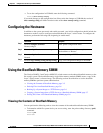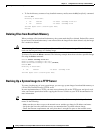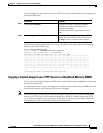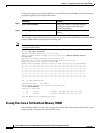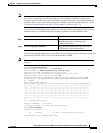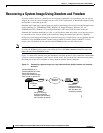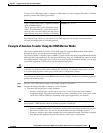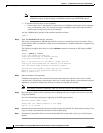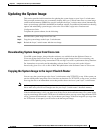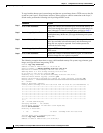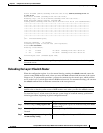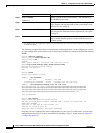
3-5
Catalyst 2948G-L3 and Catalyst 4908G-L3 Switch Router Software Feature and Configuration Guide
78-10408-03
Chapter 3 Configurations for the Layer 3 Switch Router
Configuring the Hostname
• To see the configuration in NVRAM, enter the following command:
Router# show startup-config
If you made changes to the configuration, but did not write the changes to NVRAM, the results of
show running-config will differ from the results of the show startup-config command.
Configuring the Hostname
In addition to the system passwords and enable password, your initial configuration should include the
hostname to make it easier to configure and troubleshoot the Layer 3 switch router. To configure the
hostname, perform the following task, beginning in enable mode:
Using the Bootflash Memory SIMM
The Catalyst 2948G-L3 and Catalyst 4908G-L3 switch routers use the onboard bootflash memory as the
file storage system. The bootflash memory single inline memory module (SIMM) stores a copy of the
Layer 3 switch router’s software image. The following sections describe how to use the bootflash
memory SIMM to perform system administration:
• Viewing the Contents of Bootflash Memory, page 3-5
• Deleting Files from Bootflash Memory, page 3-6
• Backing Up a System Image to a TFTP Server, page 3-6
• Copying a System Image from a TFTP Server to a Bootflash Memory SIMM, page 3-7
• Erasing Files from a Full Bootflash Memory SIMM, page 3-8
Viewing the Contents of Bootflash Memory
You can perform the following tasks to view the contents of the onboard bootflash memory SIMM:
• To determine which file system device you are accessing, enter the print working directory (pwd)
command.
Router# pwd
bootflash:
Command Purpose
Step 1
Router# configure terminal
Router(config)#
Enter global configuration mode.
Step 2
Router(config)# hostname name-string Enter a system name. In this example, we set
the hostname to “Router.”
Step 3
Router(config)# end
Router#
Return to privileged EXEC mode.
Step 4
Router# copy running-config startup-config Copy your configuration changes to NVRAM.







